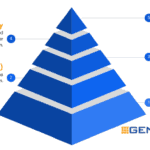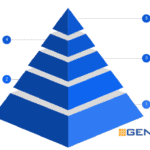Customer journey maps are a valuable tool that can help improve customer satisfaction by understanding the needs of customers and how the company can address them. One important use of the customer journey mapping process is the ability to identify customer pain points in order to eliminate them.
In this post I examine what a customer pain point is and how to use your customer journey map to identify and eliminate it.
What are Pain Points in The Customer Journey Map?
Customer Pain Points are the issues and problems that customers face in dealing with your organisation. They can arise at any point of the customer journey from prospect to customer and even ex-customer.
It’s important to reduce and/or eliminate pain points for customers because they reduce customer loyalty and goodwill, thereby contributing to poorer business outcomes.
They also tend to increase overall business costs through the need to correct issues that customers experience at a Pain Point.

Examples of Customer Pain Points
There are as many pain points as there are businesses but most organisations recognise four main types:
- Financial Pain Points: where the cost is exceeding the customer’s ability to pay or there are lower cost alternatives.
- Productivity Pain Points: Anytime you make a customer expend more time or they are delayed in achieving their goals you have a productivity pain point.
- Process Pain Points: cause issues when customers try to use your products or services or interact with your business.
- Support Pain Points: are issues in your support processes that cause customers issues.
This is not an exhaustive list – just a few examples so you know what to look for in your company.
Productivity Pain Point Examples
- Being on hold for too long – one Genroe client determined that 180 secs on hold was the tipping point between not a pain point and pain point.
- Not having enough staff to service chat requests – so customers are left waiting
- Difficult to use or confusing user interfaces to software systems – causing mis-steps and extra time to use your system.
Process Pain Point Examples
- Inconsistent responses from staff to customer questions meaning customers have to ask and re-ask the same question until they receive a consistent answer.
- Having to call back to get resolution to questions – Another Genroe client identified needing to be re-contacted to complete resolutions was a key pain point for their customers.
- Inaccurate or confusing invoicing, especially where the invoices are delivered over the duration of a project.
How to Identify Customer Pain Points Using Customer Journey Maps
Having run your customer journey mapping workshop and created your customer journey map, you’re ready to start identifying and prioritising customer pain points.
It’s not enough to guess where customers might have a problem. You need reliable data to make a determination. Here is how to collect that data.
Instrument the Customer Journey Map with Transactional Customer Feedback
Transactional customer feedback can provide a wealth of customer pain information because it focuses on the touchpoints in your customer journey.
The simplest approach is to conduct a Net Promoter Score feedback survey at each of the touch points and then compare the scores.
Some journey mapping software is able to show customer feedback information live on the map, which is an excellent way to visualise pain points.
Review Complaints
Not all customers who have a pain point complain, so complaints is not a 100% reliable source of information. However, if a customer does complain it is likely to be an important pain point for them, and probably other customers who do not formally complain.
Review all of your complaints and match them back to your customer journey map. This data is likely to amplify the transactional customer feedback you have already collected.
Be a Customer
Sometimes the simple approaches are the best. If possible, try to mystery shop your organisation’s sales and operations processes.
If you find a pain point or difficulty on the customer journey you can be sure your real customers are having the same issue.
Just a small caution: make sure you perform the mystery shopping without revealing your identity.
Once, in our customer experience consulting business, a senior manager at the bank we were working with, stated they never had problems with any of their products. There were no pain points in the business.
It turned out that his assistant was performing all of the senior manager’s banking tasks. You can imagine the sort of service the senior manager was receiving – it certainly was not like that of regular customers.
Review Service Tickets and Other Tracking Systems
Anytime a customer has to contact you to fix a problem or understand how to use your software it’s likely to be a pain point of some type.
Review help desk ticketing systems for common questions and problems that users experience.
Prioritise Customer Pain Points
Having identified the pain points the next step is to prioritise action. This can be done in a couple of ways.
Rank Pain Points by NPS
We’ve covered this above, but if you are measuring NPS, or other customer experience metric, along the customer journey simply use it to rank the relative “pain” at each of the touchpoints.
The lower the score the higher the relative pain.
It’s simple effective and allows you to track progress across the customer journey.
Rank Pain Points by Customer Value
In the real world, not all customers are created equal. Customers who contribute more profit are more important to the business and, unfortunately, their feedback should receive more focus.
Take your pain point list and rank it by customer lifetime value. Even if your not sure of exact value – use a proxy such as revenue to perform the ranking.
Taking Action to Fix Pain Points
Starting with your highest priority pain points determine how to reduce or eliminate them from your customer experience.
Collect additional data about the issue by:
- Interviewing unhappy customers
- Reading the comments in customer feedback systems
- Interviewing front line staff – they often already understand the issue and what causes it
Use a good quality root cause analysis approach to understand what causes the pain point and how to prevent it from occurring in the future.
Then take action to resolve the issue.
Get the Business Leader's Guide to Net Promoter Score Download Here








